Easter and Holy Week in the U. S. are pretty wan affairs these days. The Easter Egg Roll at the White House, a neighborhood or family egg hunt and perhaps dinner with the extended family. For many of us, the highlight is sneaking some jelly beans from our children’s candy filled baskets or perhaps nibbling the ears off their chocolate bunnies. For my family, at least, it’s also pretty nonreligious. Not so, in Spain, predominantly Catholic, at least nominally. Intricately woven designs made of palms make their appearance on the Sunday before Easter and concerts, processions, special masses and all ma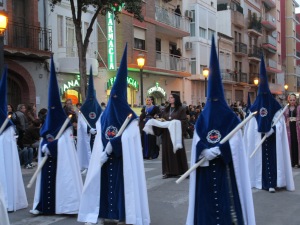 nner of holy business fill the next seven days. In Valencia, the highlight of Santa Semaña is the procession on Saturday evening, when the men, women and children of scores of religious fraternities march through the ramshackle maritime district of El Cabanyal. There’s a sameness to much of the procession, which was not yet finished when I and fellow American visitors Gerry and Dennis called it quits after more than four hours. But the colorful costumes and exotic religious nature of the event easily holds the attention of someone like me, whose religious upbringing might best be described as half-hearted. As children, my siblings and I were trotted off to my mother’s Methodist church on most Sundays, but her enthusiasm for organizing and enforcing our attendance waned as we grew older, and my father’s lapsed Catholicism did nothing to bolster it. Most of what I know today about the Bible and early Christianity comes from movies and novels – entertaining but not entirely reliable sources. So I was glad to have Gerry, a graduate of a parochial school education and product of a dyed-in-the-wool Irish Catholic family, as my guide to the various Bibical characters and saints marching by us.
nner of holy business fill the next seven days. In Valencia, the highlight of Santa Semaña is the procession on Saturday evening, when the men, women and children of scores of religious fraternities march through the ramshackle maritime district of El Cabanyal. There’s a sameness to much of the procession, which was not yet finished when I and fellow American visitors Gerry and Dennis called it quits after more than four hours. But the colorful costumes and exotic religious nature of the event easily holds the attention of someone like me, whose religious upbringing might best be described as half-hearted. As children, my siblings and I were trotted off to my mother’s Methodist church on most Sundays, but her enthusiasm for organizing and enforcing our attendance waned as we grew older, and my father’s lapsed Catholicism did nothing to bolster it. Most of what I know today about the Bible and early Christianity comes from movies and novels – entertaining but not entirely reliable sources. So I was glad to have Gerry, a graduate of a parochial school education and product of a dyed-in-the-wool Irish Catholic family, as my guide to the various Bibical characters and saints marching by us.  Salome—yes, she of the seven veils—was easily recognizable and clearly the prize role for the neighborhood sexpot. Though the Biblical Salome would have been a teenager when she danced for her stepfather King Herod and demanded the death of John the Baptist in return, the Salomes we saw ranged in age from a prepubescent 10-year-old to a siren well past the likely age of Salome’s mother. All, however, strutted their stu
Salome—yes, she of the seven veils—was easily recognizable and clearly the prize role for the neighborhood sexpot. Though the Biblical Salome would have been a teenager when she danced for her stepfather King Herod and demanded the death of John the Baptist in return, the Salomes we saw ranged in age from a prepubescent 10-year-old to a siren well past the likely age of Salome’s mother. All, however, strutted their stu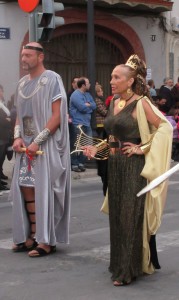 ff imperiously, uniformly posing with hand on hip and a haughty sneer on their faces. The Herods, the legions of Roman soldiers and the occasional Jesus were also easy to identify. Ditto, the personage Gerry refers to as the BVM—Blessed Virgin Mary, for those of us who did
ff imperiously, uniformly posing with hand on hip and a haughty sneer on their faces. The Herods, the legions of Roman soldiers and the occasional Jesus were also easy to identify. Ditto, the personage Gerry refers to as the BVM—Blessed Virgin Mary, for those of us who did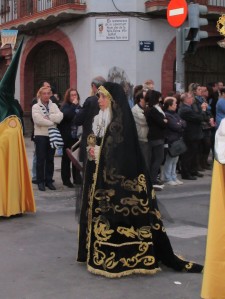 n’t have the benefit of a nun-led education.. There seemed to be multiple incarnations of her—one with a crown of thorns and another who clearly took pride of place in each fraternity’s group: of marchers.This Mary wears black mourning clothes and a long veil, topped with a halo, a combination which I can’t recall ever encountering in Methodist Sunday school classes. In fact, I don’t remember Methodists making much of Mary at all, except in her role in nativity scenes.
n’t have the benefit of a nun-led education.. There seemed to be multiple incarnations of her—one with a crown of thorns and another who clearly took pride of place in each fraternity’s group: of marchers.This Mary wears black mourning clothes and a long veil, topped with a halo, a combination which I can’t recall ever encountering in Methodist Sunday school classes. In fact, I don’t remember Methodists making much of Mary at all, except in her role in nativity scenes. 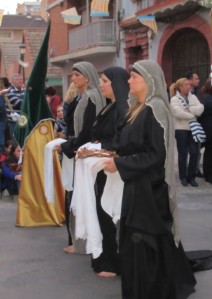 A slew of other female characters paraded by, some carrying grapes and others dates, bread, wheat, bandages and a cloth, which sometimes had an image of Jesus on it. The one carrying this I assume was St. Veronica, whose claim to fame was wiping Jesus’s face as he struggled to carry the cross up ;Mount Calvary. How does someone with a severely deficient religious education know this? It once came up in a semi-drunken game of Dictionary in college. (Did you know that a veronica is a handkerchief?)
A slew of other female characters paraded by, some carrying grapes and others dates, bread, wheat, bandages and a cloth, which sometimes had an image of Jesus on it. The one carrying this I assume was St. Veronica, whose claim to fame was wiping Jesus’s face as he struggled to carry the cross up ;Mount Calvary. How does someone with a severely deficient religious education know this? It once came up in a semi-drunken game of Dictionary in college. (Did you know that a veronica is a handkerchief?)  Like any good parade, this one also included some beautiful floats, many covered with flowers.. Each fraternity carries or wheels what seems to be essentially a mobile shrine, often with a statue of Christ on the cross or the BVM or some other Easter-related holy body. Some of the floats are especially pretty after nightfall, when dozens of votive lights twinkle on them. And then there are the hooded guys. Their outfits would look an awful lot like Ku Klux Klan robes and hoods if it weren’t for the vibrant colors of most of them: green and yellow, royal blue and white; red and purple, etc. In this case, they wear hoods not to terrorize or to escape responsibility for their actions but
Like any good parade, this one also included some beautiful floats, many covered with flowers.. Each fraternity carries or wheels what seems to be essentially a mobile shrine, often with a statue of Christ on the cross or the BVM or some other Easter-related holy body. Some of the floats are especially pretty after nightfall, when dozens of votive lights twinkle on them. And then there are the hooded guys. Their outfits would look an awful lot like Ku Klux Klan robes and hoods if it weren’t for the vibrant colors of most of them: green and yellow, royal blue and white; red and purple, etc. In this case, they wear hoods not to terrorize or to escape responsibility for their actions but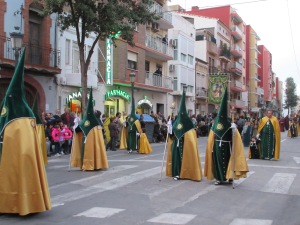 to symbolize their belief that the acts of charity they perform should be anonymous. So what does all of this have to do with shoes, you may ask. Well, you see, Gerry and I noticed that all of those guys marching in their rainbow-hued robes had shoes—sandals, actually—that matched their robes. Purple sandals. Teal sandals. Gold sandals. Orange sandals. Where do you suppose they get them, we wondered? The colors were far more likely to be found in women’s shoes, but they would hardly be large enough. Though Spanish men aren’t typically very big guys, their feet still seem to be considerably larger than your average ladies size 8 or 9–or even a 10 or 11, which are hard enough to find my big-footed female friends tell me. It wasn’t until a few days later that the shoe dropped for me–when I found out that Spain, particularly, the area around Valencia and south of it, in the Alicante region, is a major world shoe producer. Though in total output it’s dwarfed by China, Spain is the 6th largest exporter or shoes and the 7th largest in per-capita shoe consumption. (And, yes, Virginia, the U.S.is number one in per-capita consumption.)
to symbolize their belief that the acts of charity they perform should be anonymous. So what does all of this have to do with shoes, you may ask. Well, you see, Gerry and I noticed that all of those guys marching in their rainbow-hued robes had shoes—sandals, actually—that matched their robes. Purple sandals. Teal sandals. Gold sandals. Orange sandals. Where do you suppose they get them, we wondered? The colors were far more likely to be found in women’s shoes, but they would hardly be large enough. Though Spanish men aren’t typically very big guys, their feet still seem to be considerably larger than your average ladies size 8 or 9–or even a 10 or 11, which are hard enough to find my big-footed female friends tell me. It wasn’t until a few days later that the shoe dropped for me–when I found out that Spain, particularly, the area around Valencia and south of it, in the Alicante region, is a major world shoe producer. Though in total output it’s dwarfed by China, Spain is the 6th largest exporter or shoes and the 7th largest in per-capita shoe consumption. (And, yes, Virginia, the U.S.is number one in per-capita consumption.)  So, it’s probably pretty easy to get mauve-colored man sandals made. And lest any of you conclude that Spain can only produce espadrilles or colorful chunky sandals, let me remind you that American fashionistas (including, notably, Sex in the City character Carrie Bradshaw) adore the designs of Manolo Blahnik. Though his company is now American, Manolo is definitely Spanish and got his start designing for Spain’s very style-conscious females.
So, it’s probably pretty easy to get mauve-colored man sandals made. And lest any of you conclude that Spain can only produce espadrilles or colorful chunky sandals, let me remind you that American fashionistas (including, notably, Sex in the City character Carrie Bradshaw) adore the designs of Manolo Blahnik. Though his company is now American, Manolo is definitely Spanish and got his start designing for Spain’s very style-conscious females.
- Comment
- Reblog
-
Subscribe
Subscribed
Already have a WordPress.com account? Log in now.